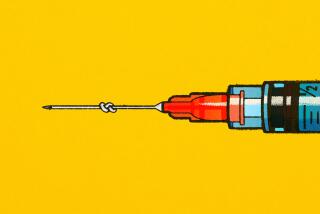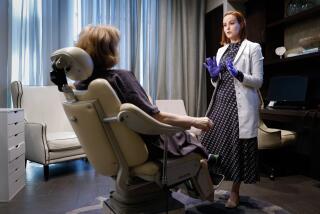Opting All Over Again for Breast Implants : Health: Whether swayed by vanity or studies showing no link between illness and saline devices, women are increasingly choosing the surgery. But one group says the research is flawed.
- Share via
As an operating-room nurse, Trudi Stanley often saw firsthand the complications that can result from silicone breast implants. Usually, it was a localized problem such as scar tissue tightening and hardening around the implant.
She knew, of course, about the moratorium on silicone breast implants imposed in 1992 by the Food and Drug Administration, greatly restricting their use, and about the flood of lawsuits contending that the implants can lead to lupus and other autoimmune diseases.
Still, she always wished she were bigger, recalls Stanley, 38, of West Los Angeles.
She investigated and formed her own opinion about the disease link. “I don’t believe it,” decided Stanley, who now works as a nurse-educator for a pharmaceutical company.
In December, she underwent breast augmentation with saline-filled implants, still on the market. Now, with her bust size increased from 32B to 34C, she says she couldn’t be happier.
While thousands of women are suing implant manufacturers and having their silicone implants removed, Stanley reflects another trend: The number of women having their breasts augmented is rising again, say physicians and industry experts.
Helping to boost interest are recent scientific studies refuting the silicone implant-disease link.
Saline breast implants, which are encased in a silicone envelope, have also been studied and found to be “safe and effective,” but autoimmune disease is still listed as an unknown risk on the product summary sheet.
This year, 90,000 to 100,000 women in the United States will undergo augmentation with saline implants for cosmetic reasons, according to estimates from the two U.S. manufacturers of saline implants, McGhan Medical Corp. and Mentor H/S, both based in Santa Barbara. That’s up from about 70,000 in 1994.
The totals include women who will replace silicone implants with saline and women who will get implants for the first time, says McGhan’s Jeff Barber.
Estimates from the American Society of Plastic and Reconstructive Surgeons and the American Academy of Cosmetic Surgery are considerably lower than the manufacturers’, but the bottom line is the same: The numbers are up. The society estimates that its members performed more than 39,000 augmentations last year, contrasted with about 32,000 in 1992. The academy estimates that 45,000 women underwent augmentation last year, up from about 28,000 in 1992.
“My practice was about 30% breast augmentation before [the ban] and went down to about 10% until about six months ago,” says Dr. Lawrence Koplin, a Beverly Hills plastic and reconstructive surgeon who performed Stanley’s operation. “Now, it’s moving up.”
Dr. Jane Norton, who practices in Palm Desert and Newport Beach, says her augmentation patients dipped to 20% of her patient load but now, once more, are nearly half.
“I think there is a lot of pent-up demand,” says Dr. Bruce Cunningham, a University of Minnesota professor of plastic surgery who chairs the silicone implant research committee for the American Society of Plastic and Reconstructive Surgeons.
Refueling interest are medical studies such as the two presented in October at the American College of Rheumatology meeting in San Francisco. Researchers from the University of Kansas and the University of Calgary refuted the silicone implant-disease link in research involving more than 4,600 women. Since mid-1994, several other studies, including one conducted at the Mayo Clinic and another at Harvard and published in the New England Journal of Medicine, also question the link.
“The studies are flawed,” counters Patti Scher, a spokeswoman for the National Breast Implant Task Force, who cites inadequate follow-up time as just one problem. The organization was founded earlier this year by women who have experienced health problems after having silicone implants.
Some studies do point to a link between the silicone implants and disease. For example, researchers from the Baylor College of Medicine in Houston presented their findings last month at the American College of Rheumatology meeting on 26 women who developed a “multiple sclerosis-like syndrome” after getting silicone implants or silicone fluid injections into their breasts.
Despite critics, the American College of Rheumatology issued a statement at the meeting, saying that the large-scale studies that have found no link “provide compelling evidence that silicone implants expose patients to no demonstrable additional risk for connective tissue or rheumatic disease.”
The studies refuting the link make the decision easier, say women who have recently undergone the procedure.
“I personally have never met anyone who’s had a problem with implants,” says Pauline, a 28-year-old Studio City business owner, who recently got saline implants and asked that her last name not be used. Her overall good health habits (with her cigarette smoking the exception), she believes, will protect her from illness.
“Everything is going to cause problems for someone,” says Donna Williams, a 35-year-old Palm Desert manicurist who got saline implants in August. “You take a risk.”
But the decision to do so is not impulsive. Stanley, the pharmaceutical company nurse-educator, booked the procedure three years ago but canceled it--not, she says, because of the moratorium. “I just wasn’t ready then to take the final step.” Both Pauline and Williams say they thought about the operation for a decade.
Women seeking breast enlargement--which costs $4,000-$7,500 in the Los Angeles area--generally fall into two groups, surgeons say: those in their 20s who have not developed as fully as they had wished and women in their 30s and 40s whose breast shape has changed with age, pregnancy and breast-feeding.
Most women want just a bit more fullness. Those asking for a D cup or larger are the exception. “I don’t push large implants because smaller ones look more natural,” says Dr. Leslie Stevens, a Beverly Hills plastic and reconstruction surgeon.
At 5 feet, 6 inches and 103 pounds, Pauline says she was “really small” and requested implants to transform her from a size AA to B.
So determined are some women to increase their profile that even less-than-perfect results are OK. “You can feel the bag through my skin and sometimes even see the wrinkles in it,” says a woman in her late 30s who got implants earlier this year. “So they don’t look completely natural, but you can’t tell through clothes. Also, the left one is a little too far to the left. So I have this gap in the middle of my chest and can’t sleep comfortably on my left side. All I wanted was to have big enough [breasts] so my bra wouldn’t always be slipping up, and that has indeed been accomplished.”
While women don’t expect implants to drastically change their lives, they do notice--and appreciate--small changes.
“I do get more looks,” says Stanley, dressed in a scoop-necked top that shows off her cleavage. “I ran into an old boyfriend, and it was the first thing he noticed.”
Says Jill, a 36-year-old West L.A. sales executive: “I wasn’t expecting them to be perfect, but they did turn out that way.” Some of her friends’ implants look obvious, but no one would ever guess her secret, she says.
*
Psychologically, younger and older women are motivated differently, finds Ann Kearney-Cooke, a Cincinnati psychologist specializing in body image who has counseled women with implants. Younger women who want implants are often trying “to augment symbolically their deficient sense of femininity,” she says.
The older women “grew up with the idea that anyone can look like Demi Moore and that that is an important sign of self-control. For them, self-esteem means the ability to control your body.”
Still, she has seen women’s perception of themselves improve after surgery, even if the results aren’t perfect.
In consultations, surgeons caution that the results are likely not to be perfect. They warn women about a host of risks, such as deflation, infection, swelling, pain, bruising and delayed wound healing. Having implants can make it more difficult to detect breast cancer. The scar tissue that normally forms around the implant can tighten too much and squeeze the implant, perhaps changing breast shape or turning hard.
“Implants are not forever,” Dr. J. Arthur Jensen, who practices at the Breast Center in Van Nuys and in Santa Monica, tells patients. At some point, they might need to be replaced. Taking care of them, he adds, is like “taking care of expensive clothes.”
Saline implants, like silicone, were grandfathered in as medical devices. (Under a 1976 law, manufacturers can continue selling devices already on the market until the FDA calls for research data, which it did on silicone implants in April, 1991. Last December, the FDA asked manufacturers of saline implants to conduct studies, which they agreed to do.)
Within three years, the University of Minnesota’s Cunningham says, follow-up results will be available on several thousand women with saline implants.






